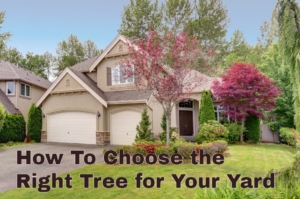How To Choose the Right Tree for Your Yard
Trees are a lovely addition to any home, but did you know they offer more than curb appeal? These woody perennial plants can help cut energy costs by providing shade in the summer and buffering cold winds in the winter. They also clean the air, reduce noise, create privacy, and can even increase the value of your property by improving its appearance.
However, before you go out and plant the first tree that catches your eye, it is important to consider several factors. The right tree for your environment and location will thrive and offer its benefits for years.
Environmental Factors to Consider:
- Temperature: Low temperatures, mainly if they occur suddenly, can damage or kill certain trees. Consider factors like elevation and the sun exposure of the planting site.
- Soil: Soil depth, structure, pH, and moisture all affect a tree’s success. Deep-rooted trees need sufficient soil depth, while shallow-rooted ones may do well in thin soil over bedrock or hard clay.
- Moisture: Do you live in a particularly dry or wet climate? If your yard floods occasionally or is constantly exposed to drying winds, then knowing the optimal soil moisture for a tree species is crucial before deciding what to get.
- Shade: Some trees, like white birch and most pines, need full sun. Others, like maples, hemlocks, and yews, thrive in shade.
- Insects and Disease: Every area has its share of troublesome insects and diseases. While disease-resistant varieties exist, planting a species of tree known for local pest problems invites stress and potential failure.
- Pollution: Pollution can accumulate and impact your trees. Some species of trees are more sensitive to pollutants like salt spray or street de-icing chemicals.
Once you’ve chosen a tree that will thrive in your environment, consider where to plant it based on your desired outcome.
Choosing the Right Location:
- Windbreaks and Screens: Low-branching conifers that hold their foliage are ideal for screening unsightly areas and creating privacy. Densely planted trees with large, fleshy leaves are best for noise reduction. Combining these types can provide year-round wind and noise buffering and filter dust from traffic.
- Shadows: Trees provide greater cooling than man-made structures by blocking sunlight and releasing water through transpiration. Position your tree to cast shade where you need it most during the hottest parts of the day and year. In cities, the proper placement of trees can be critical. Trees can provide shade and cool our cities by up to 10 degrees, which helps prevent heat-related deaths in urban areas.
- Appearance: Avoid placing trees where they divide your yard or view in half. To do so, plant on diagonal lines from the front corners of your house to add depth. Trees behind and to the side can provide background, while ones with color or unique features can act as focal points. Smaller, narrow-crowned trees define boundaries without encroaching on your neighbors’ space.
If you are still determining what trees to choose to suit your goals, you can ask a certified arborist or nursery professional. For more information on selecting the right tree, visit the Arbor Day Foundation at www.arborday.org.








